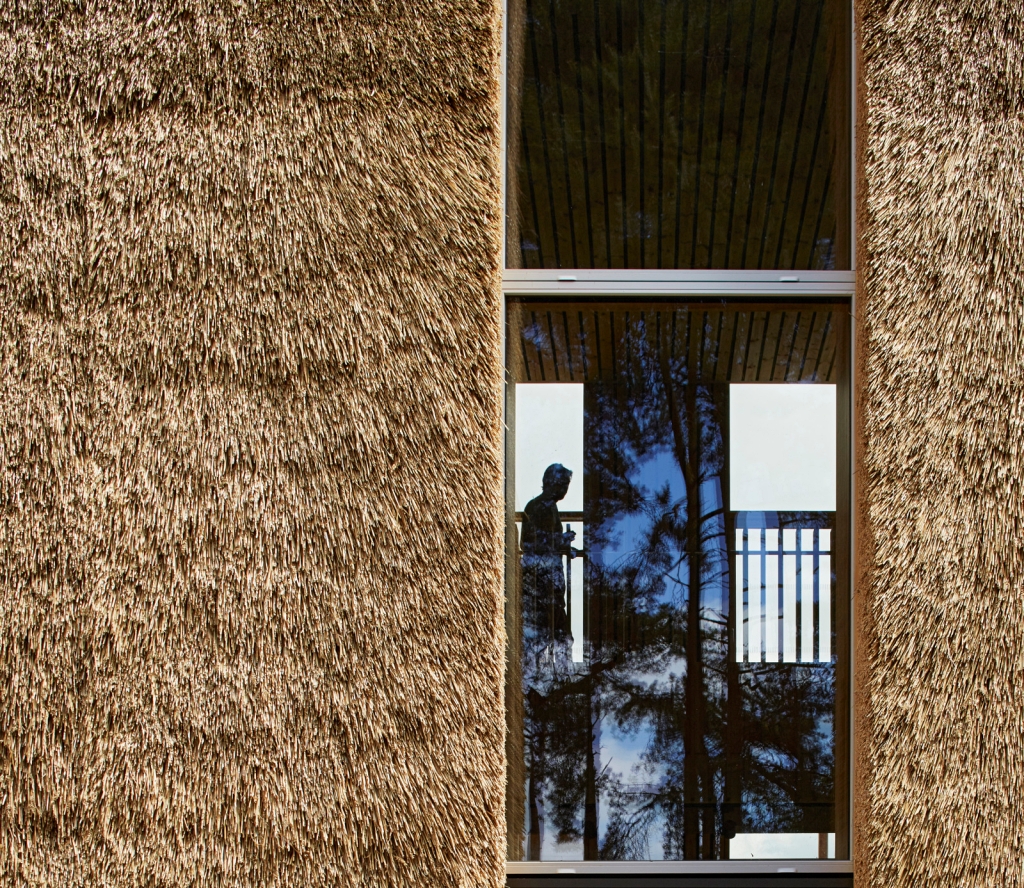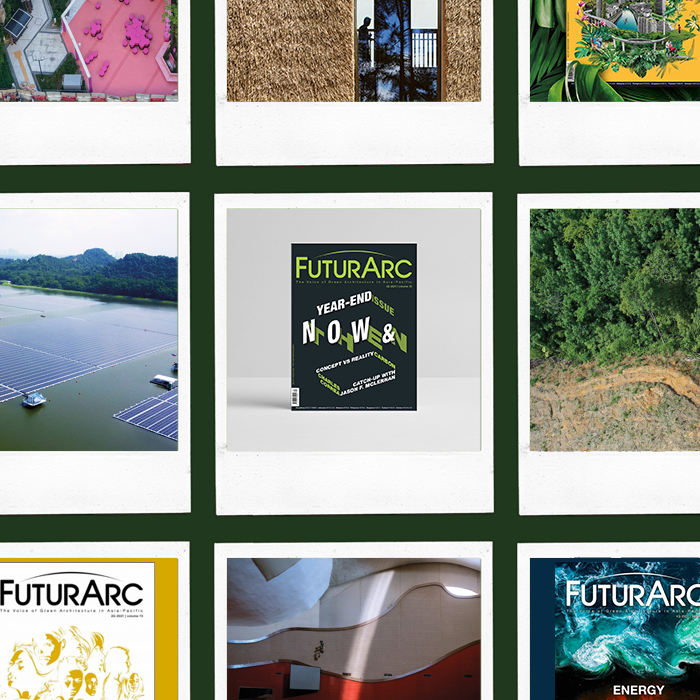A look back at 2021: Meeting Green targets; projects that make the most of what exists; and ideas taking shape
December 31, 2021
Each December, FuturArc wraps up with a Year-End Issue that reflects on current efforts in sustainability, articulates the learnings from the past and points to what we can focus on in the future. For the online edition of FuturArc, we often report on events and projects that underline Green discussions in the moment. In case you have missed it, here are some of the year’s highlights from both FuturArc’s print and online content.
Global and regional Green targets

The Enterprise Centre, UK, as part of the Build Better Now exhibition in line with COP26. Image by Dennis Gilbert 
PAM Centre. Image by Lin Ho
The annual United Nations Climate Change conference (COP26) was a highly awaited event in 2021 since the annual conference had been postponed in 2020—for the first time in history—due to the pandemic. Following COP26 that took place in November, we reported on an exhibition dedicated to highlight the role of architects and planners in the transition to a net zero carbon economy.
[News] Build Better Now at COP26: The Urgent Role of Buildings and Cities
Such conferences are avenues where top-down policies are formed, which play a key role in bringing the systemic changes needed. However, the paths from vision to policy formulation and implementation is hardly straightforward. We explored some of the complexities behind the plan for a carbon tax in Indonesia—which would make it the second country in Asia after Singapore to impose the tax.
[Happenings] Indonesia’s Progress Towards Carbon Goals: COP26 and the Carbon Tax Reform
For many countries in the region, carbon neutrality targets may have been stated, but are yet to be woven into policies for the built environment. As a result, companies and building owners have little compulsion to move towards Green. We highlighted some efforts to increase demand from the ground up for sustainable building practices in the following article:
[Commentary] Demand for Green buildings in Malaysia—a snapshot
Projects that make the most of contextual resources

Matsubara Civic Library. Photo by Kai Nakamura 
The micropark within a dense urban area in Hong Kong. Photo courtesy of Design Trust
Faced with rapidly diminishing finite resources and an unquenchable thirst for consumptive ways of life, there is a growing, urgent need for clean energy. In Singapore, a floating solar farm placed above a reservoir will generate enough energy to power an equivalent of 16,000 four-room HDB flats and reduce carbon emissions by about 32 kilo tonnes annually—a model that presents promising applications for similar infrastructure in other places.
[Project] Tengeh Floating Solar Farm
Some the most sustainable materials with a long history of usage in Asia are the fast-growing bamboo and earthen bricks. In Vietnam, many projects that utilise these materials have been recognised internationally due to both the beauty of the raw material and the artistry of putting them together. Not only do they bring the tropical buildings closer to Nature by being naturally ventilated and daylit, they are also aesthetically pleasing and exude a sense of cosiness.
[Snapshot] Bamboo and brick in Vietnam
Rapid developments in Hong Kong have resulted in a lack of open community spaces. This rest garden in between city buildings was born out of an observation of user habits: as it was used for elderly residents to wait for transport and read newspapers, the team envisioned a thoughtful approach to blend existing elements with new functions. They installed a movable furniture system and new benches to increase number of seats by more than fivefold.
[Project] A vibrant rest garden between city buildings
In recent years, there has been a tendency to reclaim bodies of water and construct buildings on the hardscaped ground. This library site is located at the corner of a reservoir, but instead of reclaiming the pond, the architects designed a structure that sits inside the water—inspired by the ancient tombs that dotted this Japanese city’s landscape.
[Project] Matsubara Civic Library
What’s next? Sustainable ideas that should be taking shape now

The nautical-themed Italy pavilion reuses waste materials like plastic bottles, coffee grounds and orange peel; it will also be repurposed when it is dismantled. Photo by Massimo Sestini 
Inside Vidhan Sabha, a building by the late Charles Correa. Photo by Nipun Prabhakar
The feminine perspective is not a biological one—it is not about a ‘woman’s point of view’. True sustainability cannot be practiced without taking into account the agency of disenfranchised people. An intersectional feminist approach calls for us to rethink the labour structures that support our systems of working and living. We need to ask the questions of whether so much building is necessary; what do we build with; who we build for; how and why we build; and how we interact with diverse ecosystems.
[Main Feature] Intersectional feminism for a sustainable future
Circularity took the front seat at several international events this year. Although only a mere 13 per cent of solid waste is recycled globally, the push for a system of production and consumption where resources are reused in a loop for as long as possible still has a long way to go. To bridge the gap between current habits and what could be done more sustainably, these pavilions have become test-beds for novel ideas in reusing waste materials and planning for the utilisation of building components beyond their life cycle.
[Project] Pavilions that build upon ‘waste’ materials
Studies have demonstrated that in its pristine state—as mangrove swamps, wetlands, savannahs, forests, etc.—nature holds more value to humankind than as exploited real estate. Some of the value would be in intangibles, such as providing a shelter; some of it would be measurable.
[Commentary] Nature left alone offers more than if we exploit it
For users, the journey of their relationship with the buildings starts after the architects have left. Just like a living being, the building is born, lives its life, transforms, witnesses many events and eventually dies. A visionary approach in designing for both environmentally and culturally sustainable projects is to situate them firmly in the context while embedding a democracy of usage in the design.
[Showcase] What happens after architects leave?
Our 2021 magazine issues
Over the past one year plus, it has been a tremendous trial to get the FuturArc magazine out to our readers when almost every aspect of the editorial process has been disrupted, including distribution or mailing services being at the mercy of lockdowns. This gave us the chance to explore and improve on other means to get FuturArc content out while still producing the quarterly print issues. You can access the digital magazine anytime, anywhere on the upgraded App or Web View—click here to sign up for a digital subscription!
1st Quarter 2021: Energy
2nd Quarter 2021: Women in Architecture
3rd Quarter 2021: Equity and Urban Interventions
4th Quarter 2021: Now & Then
Last but not least, sustainability needs to empower the various dimensions of life, which is only possible by celebrating a diversity of voices and approaches. We would like to thank all our contributors for illuminating each issue with their perspectives and insight, as well as our partners and readers—you are the reason we are still standing to this day. See you again in 2022!
To read the complete article, get your hardcopy at our online shop/newsstands/major bookstores; subscribe to FuturArc or download the FuturArc App to read the issues.
Previously Published Commentary, Online Exclusive Feature
Contact us at https://www.futurarc.com/contact-us for older commentaries.

